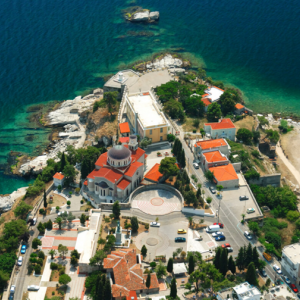
Lighthouse of Kavala
General descriptionAt the end of the Virgin Mary peninsula, there is the lighthouse, a bright guide for ships and an attraction for residents and visitors due to the exquisite view it presents.
It was built around the end of the 1880s or 1890s and its current construction dates back to work done in 1929 and immediately after the Liberation, in 1945.
After investigations that are still ongoing it was found that under the lighthouse there was a house (house) faroguard and a steep narrow staircase leading to the famous rocks of Panagia.
The rocks and the sea at this point become one. The huge smooth rocks are ideal for those who want to sit and "lose" in the blue of the sea and in the uniqueness of the landscape.
The area of "Faros" is one of the most enchanting areas of Panagia and you think it hides good secrets of the past. From the area of the lighthouse one can see panoramically the sea, admire the sunset and if the sky is clear can be seen in the distance the island of Thassos, in the west Mount Athos and east the coast of Keramoti. Previously in the area operated the homonymous secular center of the old town.
The "Faros" as a secular center began operating in 1932 and was open from Easter until the end of September. The first owner was Petros Stathis, who came to Kavala from Istanbul. "Faros" played European dance songs (waltz, tango) with an orchestra and hosted big names of the artistic fixation of the time. In this center the bourgeois of the city were entertained, danced in the light of the Lighthouse, enjoyed the program and the view of Kavala and the sea. The shop provided food and drink. The Lighthouse ceased operation in 1956.
Today the area in the area of the lighthouse is not accessible to the public because of the work being done to restore the wall at the end of the peninsula and highlight the lighthouse.
- Θ. Πουλίδου (τέρμα), Καβάλα 65201
- I. Poulidou (finish), Kavala 65201
Images
